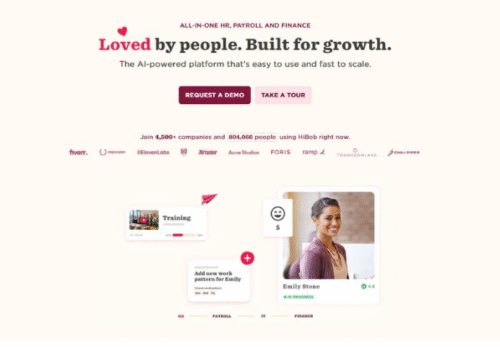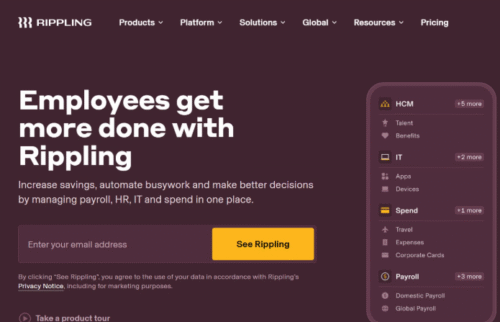What California Law Says About Dog Bites and Owner Responsibility
October 8, 2025Top 8 Most Powerful Crypto Cloud Mining Platforms of 2025: Free Mining Leading the World
October 8, 2025For many small companies, managing HR and payroll is one of the most stressful aspects of growth. From ensuring compliance with ever-changing regulations to handling employee benefits and payroll, the workload can overwhelm business owners and HR teams alike.
The right HR and payroll software can result in less admin, cleaner payroll, and an employee experience that actually works. By automating routine tasks, these platforms free small businesses to focus on what matters most: building strong teams and driving growth.
Here are six of the top solutions in 2025, each bringing a unique advantage to growing companies.
Top 6 HR and Payroll Software for Small Companies (2025)
|
HiBob – Best All-in-One HR and Payroll Platform

HiBob is more than just an HR tool. It offers a platform that supports company culture as well as day-to-day operations.
Its flexible design makes it a strong fit for small businesses looking to streamline payroll while also improving communication and engagement across teams.
Cost: Custom pricing based on company size and needs
Who it’s for: Small to mid-sized companies that want an HR system built for growth and employee engagement.
Standout benefits: Strong focus on culture-building features, customizable workflows, and intuitive payroll management.
Pros:
Wide range of tools in one platform – HiBob combines HR management, payroll, onboarding, performance tracking, and employee engagement features in a single system, reducing the need for multiple providers.
Automation reduces manual work – Streamlined workflows update and sync data automatically, helping teams save time and limit administrative errors.
Data-driven insights – Built-in analytics provide visibility into workforce trends, such as retention and absenteeism, which can guide better decision-making.
Focus on employee experience – Features like surveys, feedback channels, and learning modules emphasize engagement and career development, not just administration.
Customizable processes – Businesses can adapt workflows for onboarding, compensation reviews, or performance evaluations to match their specific needs.
Scalable for global teams – Support for US and UK payroll, plus integrations with international providers, makes it suitable for companies with cross-border operations.
Cons:
Can be complex – The depth of features may feel excessive for startups or teams that only require simple payroll processing.
Cost considerations – Pricing is not fully transparent, and accessing advanced modules may require higher-tier plans.
Learning curve – With so many features available, HR teams may need time and training to get the most from the platform.
Rippling – Best for global payroll & automation

Rippling goes beyond payroll by combining HR, IT, and finance functions in one unified platform. From onboarding new hires to managing global payroll, it centralizes key business operations and reduces the need for multiple systems.
Cost: Custom pricing based on company size and selected modules.
Who it’s for: Small to mid-sized companies that want a single platform to manage employees, payroll, and even IT tools.
Standout benefits: Seamless integration across HR, payroll, and IT, global payroll capabilities, and advanced automation.
Pros:
Wide coverage of business functions – Rippling manages payroll, benefits, HR data, and IT provisioning, creating a single source of truth.
Global payroll support – Companies can pay employees and contractors in multiple countries, making it attractive for distributed teams.
Strong automation – Tasks such as onboarding, role-based app access, and payroll calculations are streamlined to reduce manual work.
Integration-friendly – Rippling connects with hundreds of popular business apps, allowing companies to sync HR and payroll data across tools.
Scalable design – The modular setup lets businesses start with payroll or HR and expand into IT or finance management as they grow.
Compliance assistance – Built-in compliance features help ensure tax filings and labor law requirements are met across regions.
Cons:
It may be overbuilt for very small teams – Businesses with only basic payroll needs could find it too advanced or costly.
Pricing varies by modules – Costs can increase quickly if multiple functions (like IT management) are added.
Learning curve – While powerful, Rippling’s broad capabilities may take time to master fully.
BambooHR – Best for HR usability
BambooHR is designed with simplicity and usability in mind, making it one of the most approachable HR platforms for small businesses.
It focuses on employee data management and performance, with payroll features built in to streamline HR processes.
Cost: Custom pricing, with plans based on company needs
Who it’s for: Small businesses seeking an intuitive HR system with strong data management and payroll support.
Standout benefits: Easy-to-use interface, customizable reporting, and an emphasis on people-focused HR tools.
Pros:
User-friendly experience – BambooHR is known for its clean design and simple navigation, which reduces the learning curve for HR teams.
Centralized employee data – Stores all employee information in one place, making record-keeping and compliance easier.
Customizable reporting – Offers flexible reporting options that allow businesses to track the metrics most relevant to them.
Integrated payroll – Connects HR data directly to payroll, reducing manual entry and errors.
Employee self-service – Staff can manage time off requests, view pay information, and update details independently.
Performance management – Built-in tools for reviews and goal tracking help support employee growth.
Cons:
Payroll features are not as extensive – Compared to larger providers, its payroll module may feel basic for complex needs.
Limited global coverage – Best suited for U.S.-based businesses rather than international teams.
Pricing transparency – Exact costs require a quote, which may complicate comparisons.
Paychex – Best for compliance & payroll expertise
Paychex has been a longstanding leader in payroll and HR services, offering flexible solutions that scale from very small businesses to larger organizations.
Its mix of software and expert support makes it a reliable choice for companies that prioritize compliance and accuracy.
Cost: Pricing depends on company size and services selected
Who it’s for: Businesses that want trusted payroll services with strong compliance and customer support.
Standout benefits: Scalable payroll, 24/7 customer service, and in-depth tax and compliance expertise.
Pros:
Established reputation – Paychex is a well-recognized name in payroll and HR, trusted by thousands of businesses.
Scalable solutions – Offers packages suitable for companies of all sizes, from startups to enterprises.
Hands-on support – Provides 24/7 customer service and access to HR professionals for guidance.
Robust compliance support – Helps businesses navigate payroll tax filing, labor laws, and reporting requirements.
Comprehensive features – Beyond payroll, it includes time tracking, benefits, retirement planning, and HR tools.
Customizable plans – Businesses can select only the features they need.
Cons:
Can be costly – Pricing often exceeds that of newer competitors, especially for smaller businesses.
Interface may feel dated – Compared to newer platforms, its design is less modern.
Steeper learning curve – The wide feature set can be overwhelming at first.
Paylocity – Best for mid-market employee engagement
Paylocity offers a modern, cloud-based payroll and HR system built for businesses that want both automation and employee engagement tools. It aims to help smaller organizations save time while also building a stronger workplace culture.
Cost: Custom pricing depending on features selected
Who it’s for: Companies looking for a full-service HR and payroll system with strong engagement features.
Standout benefits: Advanced automation, mobile-friendly access, and employee communication tools.
Pros:
Cloud-based convenience – Accessible from anywhere, making it easy for remote and hybrid teams to use.
Strong automation – Handles payroll, tax filing, and reporting with minimal manual input.
Employee engagement focus – Tools like surveys, chat, and recognition features support company culture.
Mobile app – Employees can view pay stubs, request time off, and clock in from their phones.
Scalable features – Suitable for both small businesses and growing organizations.
Comprehensive HR tools – Covers performance management, benefits, and compliance alongside payroll.
Cons:
Best value for mid-sized firms – Some smaller businesses may find its full-service approach more than they need.
Pricing not public – Costs are only available via quote.
Can be complex – The wide array of features may require training for HR teams.
UKG – Best for scalability
UKG (Ultimate Kronos Group) is a comprehensive HR and payroll solution designed for organizations that need deep functionality across workforce management, compliance, and employee engagement. While it is often used by larger companies, its scalable tools can also support small businesses that want enterprise-grade capabilities.
Cost: UKG Pro typically ranges from $27 to $37 per employee per month, while UKG Ready starts at approximately $10 per employee per month.
Who it’s for: Small to mid-sized businesses that need robust payroll and HR features with strong compliance support.
Standout benefits: Extensive workforce management tools, advanced compliance capabilities, and strong employee engagement features.
Pros:
Full-featured platform – Offers everything from payroll and HR to time tracking, scheduling, and analytics.
Compliance expertise – Strong support for tax, labor law, and reporting requirements.
Scalable – Can grow with a company from a small business to an enterprise.
Employee engagement – Includes recognition tools, surveys, and communication features.
Workforce management – Advanced tools for managing shifts, attendance, and labor costs.
Analytics – In-depth reporting for HR and payroll data to support better decision-making.
Cons:
Complexity – The extensive feature set can feel overwhelming for smaller businesses with basic needs.
Cost – Pricing can be higher compared to competitors, particularly for startups.
User experience – Some customers find the interface less intuitive than newer platforms.
Bottom Line
For small businesses in 2025, the right HR and payroll software can significantly reduce administrative work while improving compliance and employee experience.
While Gusto, BambooHR, Paychex, Paylocity, and Rippling each have strong offerings, HiBob stands out as the most comprehensive and scalable choice, designed to grow with companies and deliver a modern, employee-first payroll and HR experience.
FAQs: HR and Payroll Software for Small Companies
What is the best payroll software for small companies?
The best payroll software for small companies depends on the organization’s size, budget, and feature needs. Platforms like HiBob, Rippling, and Paychex offer comprehensive payroll solutions with automation, tax compliance, and benefits administration.
For businesses seeking simplicity and affordability, Gusto or BambooHR may be more suitable. The optimal choice balances cost, ease of use, and integration with existing HR tools.
What is the best HR and payroll software for mid-sized companies?
For mid-sized companies, the top HR and payroll software combines people management, payroll automation, and employee engagement features.
HiBob stands out for its all-in-one platform that streamlines HR, payroll, and benefits while supporting a strong employee experience.
Other leading options include Rippling, Paylocity, and UKG, each offering specialized functionality for payroll, workforce management, and compliance.
Can small businesses manage payroll without HR software?
Yes, small businesses can manage payroll without dedicated HR software, particularly if they have only a few employees.
However, manual payroll processing increases the risk of errors, compliance issues, and inefficiencies.
Using an integrated HR and payroll platform automates tax calculations, streamlines benefits administration, and provides valuable reporting insights, which saves time and reduces risk as the business grows.
How do HR and payroll software help improve employee experience?
Modern HR and payroll software centralizes payroll, benefits, and personal data in an accessible, user-friendly interface.
Employees can view pay stubs, manage time off, and access benefits information independently.
Platforms like HiBob and Rippling also offer engagement tools such as surveys, recognition features, and performance tracking, which foster transparency, trust, and overall employee satisfaction.
